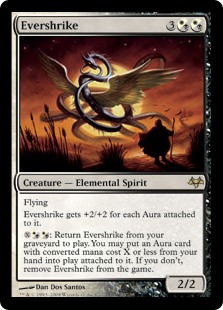
Orzhov is an odd guild, you might think black and white are the most different, distinct and opposite of the possible pairs in the colour pie for flavour reasons however in reality they are very similar colours. Clunky is how I would describe both overall. Not because they lack good cheap cards but because their cards tend to be very one dimensional, they do one thing well but are dead weight when you don't need to be doing that thing. Neither have great card quality either so you tend to have just work with what you have got. There are not even that many things one colour can do that the other cannot. White can Disenchant things and black has the capacity to draw cards are the two major ones. Most times that you play a black white deck you are basically playing a mono archetype and splashing a few power cards from the other. Even split black white decks tend not to add much over a splash and are typically awkward on the mana base. More control black white decks can be made but they are slow, vulnerable and rather boring to play. This doesn't mean that they can't be really good but I do try and avoid them.
Specifically looking at the gold cards and we have a fairly odd bunch. As the colours are quite similar the most powerful cards tend to be versions of things that the mono colours basically do but just that bit cheaper or better. There is a decent number of fairly powerful and worthy cards however they are less played than the weaker Azorius and Izzet cards because the colour pairing is uninspiring rather than the gold cards themselves. Some of the best Orzhov cards are not technically gold cards but do need to be played with access to both colours of mana to be worth it, as such the top ten is a top thirteen just in case you don't think they should count! Before the top thirteen however I am going to talk about the cards that are not on the list but have had a little cube love in their time.
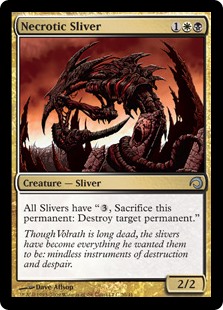
Evershrike
Zealous Persecution
Necrotic Sliver
Edgewalker
Deathgrasp
Cartel Aristocrat
Deathgrasp is a good combo kill card and an OK midrange utility card. It is a bit like Aurelia's Fury, very occasionally you still want it but overall it is just slightly too expensive to be convenient. With black devotion decks being able to produce epic amounts of mana and still have no problem splashing I could see Deathgrasp increasing a little in popularity but then Drain Life works pretty fine in that slot too without the phaff of a splash.
Zealous Persecution is great in a weenie deck against another weenie deck. Thing is, this is not a common occurence in cube even before you consider that to play this you need to be black and white, which means that less black and white drafters should be at the table, and so with black and white being the main weenie colours you will find this to be rarely at its best. It can be OK as a cheap mini wrath for a control player who can get some use out of the other ability with tokens etc but at that it is not worth a cube slot, certainly not a gold one.
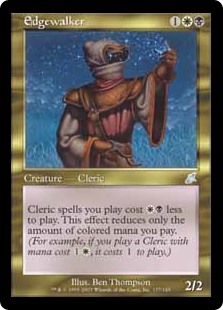
Necrotic Sliver is a great sliver to the point it is fully playable with no other slivers at all. Sadly it totally epitomises Orzhov in that it is the slowest clunkiest midrange card you can find. Great draft all rounder but too expensive to be a good removal spell and too impotent a body to be gaining much tempo.
Edgewalker is wonderful, you can cast BW clerics for free! Very few cards reduce the coloured mana requirement of spells and so this will always be a very interesting card even if clerics are a fairly awkward tribe to try and build with. As yet I have not had one stand out but it is only a matter of time before we hit some good cleric lords or top quality stand alone clerics that make the tribe and the Edgewalker viable.
Evershrike is one of the more interesting Orzhov cards. Graveyard recursion is easy to build around and abuse and this does so in an unusual way. I have not found a deck that easily breaks the Shrike but I have not tried that hard at doing so. Too narrow for most cube situations but easily cube power level in the right deck.
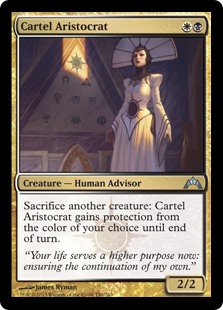
Cartel Aristocrat is the most played of all those card not in the Top 13 list and gets a bit more play than some on the list. I have always deemed it too niche and low powered for the cube as it not only narrow but a support card in an archetype that is itself narrow. Having a sacrifice outlet is very powerful in certain decks, it is useful in general to fizzle things like Lightning Helix and when it makes your guy unblockable and very hard to kill into the bargain a humble 2/2 starts to look pretty good. It won't make a huge impact on the board but it will be annoying and will probably still be there when the game ends. Great in the BW humans and tokens themed decks but otherwise basically unplayed.
Orzhov Charm is one of the few that has seen no play at all and it probably wont unless some graveyard based combo deck operates around a one drop. The removal portion is fine but not good enough without at least one of the other effects being really powerful which they struggle to be close to in any present archetype.
Right, on with the top 13.
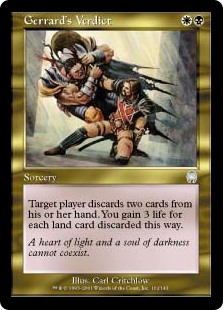
13. Gerrad's Verdict
A cheap way to get a two for one but usually far less brutal than a Thoughtsieze or similar. The life aspect is nice and gave the card some added utility when you needed to just gain life and used it on yourself. In very much the same way that a bit of life doesn't make Lightning Helix better than simple old Bolt the life on this comes nowhere near making it better than Hymn to Tourach. With this being double colours and a bit too far down the pecking order of card discard spells it has not had a main cube slot for very many years now. It is hard to time it well compared to other discard, use it too early when their hand is full and allow them to pitch irrelevant cards, save it too long and it doesn't hit much of anything at all. This on top of black white having little card quality of its own means you cannot have too many cards that do nothing for your position but cost you a valuable card.
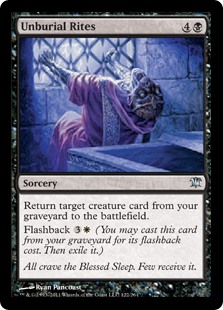
12. Unburial Rites
Unburial Rites is the first of the cards that isn't really gold, infact, to play it you don't even need to have black mana which at least is the case for the other versions. In reality this is too slow for the cube. Reanimation needs to be done early to be having the most advantage from your stupid fatty, by the time you can be doing this your opponent can have easily hard cast things that don't look to bad compared to what you plan to cheat down. The only places you can suitably play this is in controlly decks using cards like Gifts Ungiven to tutor up the bits you needs. Basically it is OK if it is consistently going to be a card you get to your bin before casting it. Getting a two for one out of it is fine as well but really you should either be making something with it that is going to make the 2 for 1 off the Rites irrelevant. Nine is also a lot of mana for a two for one, see Gerrads Verdict and how that doesn't make the cut at two...
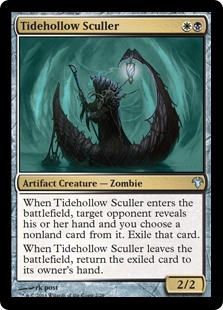
11. Tidehollow Sculler
A fine 2/2 body for 2 with both Mesmeric Fiend and potential artifact synergy bolted on. The artifact synergy makes him a lot more viable in a lot of different decks however the intense colour requirement on him usually rules him out of those in the end. Mesmeric Fiend effect on a 2/2 is usually some decent tempo, it is back breaking against removal light decks (typically combo) and at worst tends to eat a removal spell they would rather have aimed at something more than a Grizzly Bear. Sadly the quality of creatures has risen so much that Sculler is no longer played much. Combo is weak and uncommon, there is lots more removal floating around and a 2/2 will just trade badly with any number of similar dorks that have already obtained card advantage (Snapcaster, Trinket Mage etc) or sit on the sidelines and do nothing compared to actual threats people might make. He don't do that well against lots of the agro one drops so from two mana onwards he is basically an Oblivion Ring waiting to be removed. That being said any deck entirely relying on black for it's removal will struggle more than usual to deal with Sculler what with it being black, gold and an artifact leaving only Edict effects, mass removal and -X/-X effects.

10. Stillmoon Cavalier
This is a great draft card as it is such great filler. You can play it in either mono coloured deck to good effect, it is very strong when you come up against white or black mages, it is a fine early play and it scales well into the late game. It is a zombie too for all those lovely Gravecrawlers... Outside of draft it gets basically no play by virtue of costing three mana, doing nothing immediately and nothing much without further mana investment all the while being utterly dead to a single ping. The red mages chuckle to themselves at this kind of card. I don't typically like protection cards but this somehow feels fairer as it is only its own colours!
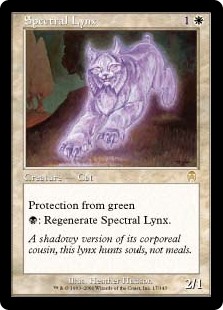
9. Spectral Lynx
A golden oldie that just about manages to keep up with the times. Most comparable to River/Mire Boas but essentially two colours not one. Protection is usually better than a landwalk effect, it is vastly better defensively and usually about as good offensively but this probably only makes the Lynx equal to the Boas in light of being a gold card. People avoid specific colour hosers in all but draft formats in the cube and so it is more that gentlemanly behaviour than the power of the cards that means they get little play. The Lynx is more commonly found in people's decks than the Boas because there is less similar sorts of cards in white and black while green is full of high endurance cheap threats.
8. Ashen Rider

I don't think I have seen this hard cast yet in my cube but then you don't really play 8 mana 5/5s to hard cast them. Generally speaking this is the insurance card in the cheat it into play decks. It is good in that it works fairly well with most of the ways you can go about doing this from Oath to Reanimate and co to Sneak Attack, Show and Tell and even Flash. You don't tend to play it to win the game but as a way to not lose the game. It turns out a 5/5 flier is not that quick of a clock nor that scary of a threat but it is certainly a lot better than no body attached. You are of course playing it to exile one or two things you have few other ways to deal with in the deck and in this capacity there is no better card to play. It condenses your list being both a combo piece as well as a valuable out card allowing your deck to be more consistent and powerful at once. Fairly niche card, even when you play with it you usually don't want to have to find it and play it, but as it is the best at doing what it does it has retained its main cube slot.

7. Sin Collector
While Sin Collector deals with all the problems Tidehollow Sculler has it is a little bit narrow and looks most like a sideboard card in the cube. Costing one more than Sculler would be totally fine to pay to ensure the card doesn't return when you lose your dork, sadly the reduction in possible targets makes it dead far too often against the meta. Even if it just had Duress functionality it would be a commonly played card but as it is you risk having a 2/1 for 3 too often.
6. Mortify
Mortify used to look like the runt of the litter when placed next to Putrify but Theros block has thrown in a bunch more targets for the card. Most of those are also creatures and so the Mortify has not gained as much value as Ronom Unicorn has. The thing with Mortify is that there are not many quality cards you can play that kill enchantments but also have other useful functionality. Mortify will basically never be dead and it will give you a whole added bit of security over something like a Doom Blade. When your options are play Disenchant and risk having a do nothing card, play nothing and risk losing to awkward enchantments, play Kami of Ancient Law and have a weak card, or play Mortify I know where I am going most of the time with my control decks. It is not a bargain price but it is fair, comes with no restrictions and has the all important instant speed.
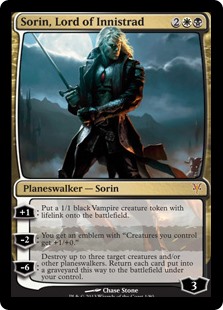
5. Sorin, Lord of Innistrad
Not the best planeswalker and not the worst. Compared to Elspeth, Knight-Errant he is really limp but then most things are. She is the walker he is most comparable to in effects at least. Sorin is fairly slow to grow but has some useful things you can be getting on with right away. He has reasonable in built synergy and fairly unusually a really strong ultimate. It is cheap and not only gives you great legs to win with it will stop your opponents onslaught dead in its tracks. I thought he would be better than he is and don't know exactly why he hasn't performed that well. Lifelinking 1/1s don't do that much to the board state, three loyalty to begin with is low and only a single +1 to grow keep him quite calm. On colour and in a draft situation it is hard not to play him as basically all planeswalkers that do something are good. In more constructed events it is very hard to include him because you have so many more powerful or direct options.

4. Obzedat, Ghost Council
Another fantastic reason why sorcery speed removal is the nut low. This dork is very powerful for the mana cost and he is also just a stand alone powerful threat. On top of this he is a clunky gold card in clunky colours with a horrendous coloured mana requirement. Typically these are the kinds of cards I avoid putting in the cube but at just five mana rather than the six plus you tend to find most stand alone gold legendary threats occupying Obzedat has seen a fairly decent amount of play, and not just in two colour decks I should add! I like that he gives you choices, do you blink them out to protect from sorceries and to trigger the Syphon Soul or do you leave them about to block? A 5/5 for 5 with no firststrike/flying/trample etc is not that great of a deal. While the body is fine it is the versatility of the card that makes it good. You can slap it down and go full steam ahead doing 23 points of damage over 3 attacks and gaining you 8 to boot. You can leave it there doing nothing bar flickering in and out and just apply the Vampire Nighthawk effect. It has great synergy with any instant speed global removal and he is very hard to kill. Five toughness, immune to sorcery speed things should you like and being black heavily limit what actually deals with him and unlike other medium sized no frills fatties you have to kill him, you can't just stale mate and wait for something else.
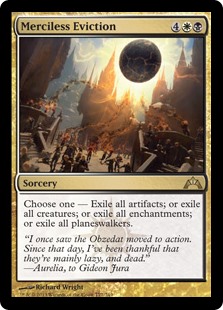
3. Merciless Eviction
This is the accept no substitutes wrath card. When you absolutely positively need to kill all of one kind of thing this is your spell. It is not cheap, it is not that tricksy or clever, it isn't instant or one sided but it totally deals with stuff and that is what you want your Wraths to do. Usually this is just killing creatures and so it can seem weak compared to a 4 mana wrath but in reality the cube dorks are so robust the four mana wraths tend to me more like a mild cull. Merciless Eviction will clear a board and it will do so without a whole bunch of them jumping right back out of the graveyard and into your face. In addition to being a super Wrath you can also use this card as the worlds worst Revoke Existance come Dreadbore. Often you really need to kill a non creature (non land) permanent more than the dorks in play but it is really rare to hit more than one of those targets. It feels terrible when you have to spend six mana to take out one thing but then it is a lot better than not having that option and losing to that one thing. You will occasionally play against artifact based decks such as big red or affinity with Merciless Eviction and if you are not already dead by the time you can cast it you will pretty much end them. Safety and versatility at the cost of being unwieldy.
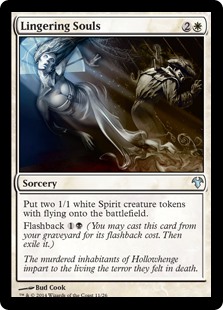
2. Lingering Souls
One of those fairly generic cards that is just a good chunk above the curve of what you should expect for your mana. This makes useful tokens more effectively than any other token generating card. It is cheap, it is powerful, it is flexible, it has synergy with graveyardy things and global pump things and is made of win. It is one of those cards plenty good enough that it winds up in control decks and agro decks. As you get to cast it twice and as each half provides you with a suitably annoying board presence that you generally have to deal with it you can fairly easily turn Lingering Souls into a two for one at worst. It is very splashable both in white and black decks, the latter due to heavy numbers of good discard outlets enabling you to play it even without any white mana.
1. Vindicate

Obviously Vindicate at number one, one of the greatest ever gold spells. Like Lingering Souls it goes in most decks that have black and white mana yet much more so. Desert Twister is the functional comparison of this card and that bad boy is an unplayable six mana which doesn't seem an unreasonable price for the effect. Vindicate just always solves your current problem, it isn't often that unfair when you do so as paying three mana to kill a single target is the top end of what you expect to pay. The quality of the card lies in the fact that it is which ever removal spell you want it to be from Dreadbore to Pillage to Creeping Mould. It is the least dead a card can ever be. On top of this it grabs the occasional free win by virtue of kicking someone right in the mana base when they are struggling. The very best cards are always hardest to explain why they are so good. They do a very basic thing cheaper than any alternatives without any fiddly stipulations such as Lightning Bolt. They do what they say on the tin, they do it effectively and they do it for a bargain.